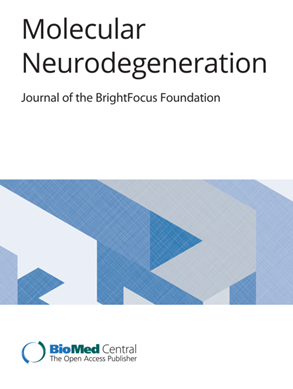Apolipoprotein E in Alzheimer’s disease: molecular insights and therapeutic opportunities
IF 17.5
1区 医学
Q1 NEUROSCIENCES
引用次数: 0
Abstract
Apolipoprotein E (APOE- gene; apoE- protein) is the strongest genetic modulator of late-onset Alzheimer’s disease (AD), with its three major isoforms conferring risk for disease ε2 < ε3 < ε4. Emerging protective gene variants, such as APOE Christchurch and the COLBOS variant of REELIN, an alternative target of certain apoE receptors, offer novel insights into resilience against AD. In recent years, the role of apoE has been shown to extend beyond its primary function in lipid transport, influencing multiple biological processes, including amyloid-β (Aβ) aggregation, tau pathology, neuroinflammation, autophagy, cerebrovascular integrity and protection from lipid peroxidation and the resulting ferroptotic cell death. While the detrimental influence of apoE ε4 on these and other processes has been well described, the molecular mechanisms underpinning this disadvantage require further enunciation, particularly to realize therapeutic opportunities related to apoE. This review explores the multifaceted roles of apoE in AD pathogenesis, emphasizing recent discoveries and translational approaches to target apoE-mediated pathways. These findings underscore the potential for apoE-based therapeutic strategies to prevent or mitigate AD in genetically at-risk populations.载脂蛋白E在阿尔茨海默病中的作用:分子见解和治疗机会
载脂蛋白E (APOE-基因;apoE-蛋白)是迟发性阿尔茨海默病(AD)最强的遗传调节剂,其三个主要亚型ε2 < ε3 < ε4。新出现的保护性基因变体,如APOE Christchurch和REELIN的COLBOS变体(某些APOE受体的替代靶标),为抗AD的恢复能力提供了新的见解。近年来,apoE的作用已被证明超越了其在脂质转运中的主要功能,影响多种生物过程,包括淀粉样蛋白-β (Aβ)聚集、tau病理、神经炎症、自噬、脑血管完整性、保护脂质过氧化和由此导致的铁致细胞死亡。虽然apoE ε4对这些和其他过程的有害影响已经得到了很好的描述,但支撑这一劣势的分子机制需要进一步阐明,特别是要实现与apoE相关的治疗机会。这篇综述探讨了apoE在AD发病机制中的多方面作用,强调了apoE介导的靶点通路的最新发现和翻译方法。这些发现强调了基于载脂蛋白的治疗策略在基因高危人群中预防或减轻阿尔茨海默病的潜力。
本文章由计算机程序翻译,如有差异,请以英文原文为准。
求助全文
约1分钟内获得全文
求助全文
来源期刊

Molecular Neurodegeneration
医学-神经科学
CiteScore
23.00
自引率
4.60%
发文量
78
审稿时长
6-12 weeks
期刊介绍:
Molecular Neurodegeneration, an open-access, peer-reviewed journal, comprehensively covers neurodegeneration research at the molecular and cellular levels.
Neurodegenerative diseases, such as Alzheimer's, Parkinson's, Huntington's, and prion diseases, fall under its purview. These disorders, often linked to advanced aging and characterized by varying degrees of dementia, pose a significant public health concern with the growing aging population. Recent strides in understanding the molecular and cellular mechanisms of these neurodegenerative disorders offer valuable insights into their pathogenesis.
 求助内容:
求助内容: 应助结果提醒方式:
应助结果提醒方式:


